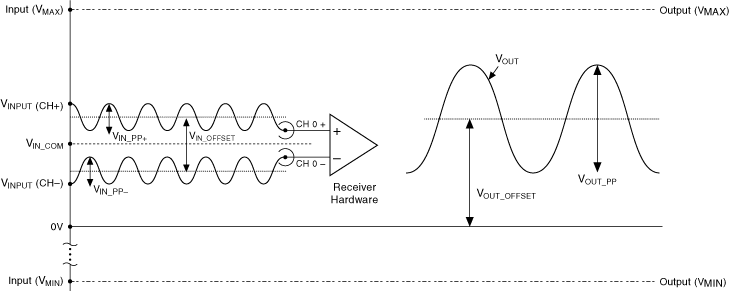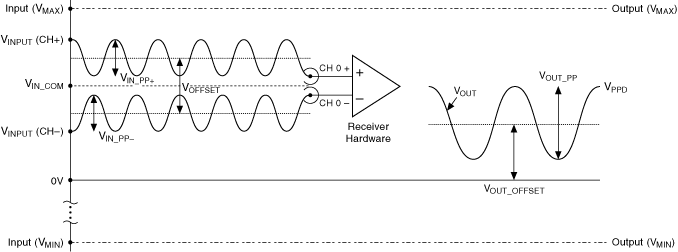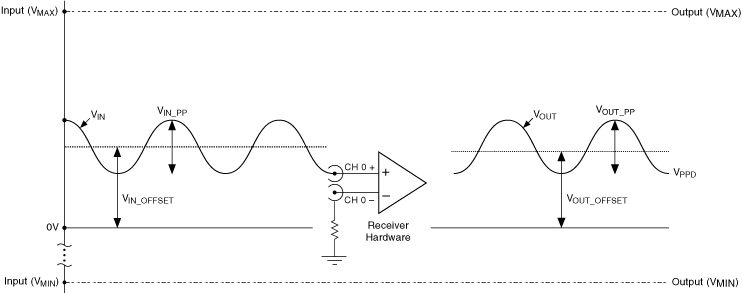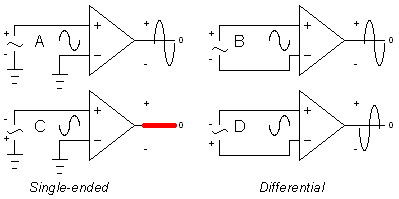Differential and Single Ended Inputs Explained
Differential signalling is a method for electrically transmitting information using two complementary signalsThe technique sends the same electrical signal as a differential pair of signals each in its own conductorThe pair of conductors can be wires in a twisted-pair or ribbon cable or traces on a printed circuit board. A basic single-ended ADC can be used to measure a differential signal by connecting each of the two inputs to a single-ended ADC channel sampling them sequentially and comparing the results in software.

Differential And Single Ended Operation I Q Interface Ni Rf Vector Signal Transceivers Help National Instruments
Using the simplified triangle amplifier symbol a differential amplifier looks like this.

. Differential signaling which is less common than single-ended signaling employs two complementary voltage signals in order to transmit one information signal. For a single-ended measurement the LabJack converts the difference between the voltage at an input and ground. Each side of a differential pair carries the same magnitude signal but with opposite polarity.
The red rectangles represents single-ended transducers. However we can use these differential encoders in the same way we would use a single-ended quadrature encoder. Electrically the two conductors carry voltage signals.
The differential signal and the cabling method used eliminates common mode noise. The LT6200 combines fast settling and good DC linearity. The LTC2389-18 accepts both single-ended unipolar and single-ended bipolar input signals directly.
Differential is measured from one input to the other input. Single ended would mean between one input and GND but that is a. Other so-called pseudo-differential approaches also exist but all have little effect on dynamic common-mode noise since the two.
This is because the two differential inputs can be 180 out of phase as shown in Figure 3. Using single-ended inputs has the advantage of giving twice as many inputs as. One carries the signal and the other carries the inverted signal.
Its what a signal sees if it flows into one input and out the other input. A standard single-ended quadrature encoder has up to 3 channels A B and Z. The blue rectangle on the left is a six-axis force transducer which has 6 low level differential ended outputs and an analog ground AGND.
For most single-ended applications it is recommended that the LTC2389-18 be driven using the LT6200 ADC driver configured as a unity-gain buffer as shown in Figure 9. R IN must be chosen carefully based on the source impedance of the signal source. The TS wants single-ended to differential not differential to single-ended which an instrumentation amp does.
Most data acquisition systems provide both a single ended and a differential input connection. Each method of wiring has its advantages and drawbacks. Unlike normal amplifiers which amplify a single input signal often called single-ended amplifiers differential amplifiers amplify the voltage difference between two input signals.
Higher values of RIN tend to degrade both the noise and distortion of the LT6350 and LTC2378-18 as. If you are using a differential sensor you must change the coupling to differential. The ground and noise problems can be solved by differential inputs.
Fully-differential mode - AIN and AIN- - 180 out of phase. This makes the dynamic range twice as much as in case of single-ended ADC that is 2V dd. Crutschow your right sorry mis read Yes the OP wants either a transformer or a single ended to differential amplifier.
Full bridge strain gauges are differential while half bridge gauges quarter bridge gauges and ICP sensors are single ended. So one information signal requires a pair of conductors. Both these types of amplifier are powered in the same way but the differential amplifier amplifies the difference between its two inputs whereas the single ended amplifier amplifies the difference between its single input and ground.
Enjoy the benefits of. This type of configuration allows for the DAQ. A sensor with a differential output can be wired for single-ended by wiring the low side to ground.
The HIGH level is brought up to a logic level 5 V 33 V etc and the LOW level is defined as zero. Single-ended and Differential Input Configurations. Some sensors for example amplified versions of Apogee SP and SQ series sensors only have a single output and must be wired into a single-ended channel.
Differential pairs are different. Its what a signal sees when it appears on both inputs. The input impedance is instead set by resistor R IN.
In the inverting amplifier configuration the single-ended input signal source no longer directly drives a high impedance input of the first amplifier. If you are setting the InputMode to Voltage AC Voltage DC or Active sensor the coupling will be automatically set to single ended. In theory given the same voltage range for single-ended and fully-differential inputs the fully-differential inputs will have double the dynamic range Figure 2.
To use your quadrature encoder with your DAQ card connect channels A B and Z to the counters SOURCE AUX and GATE pins respectively. Because they require only one physical connection per input a single-ended configuration can monitor. Equation 1 gives the SNR for an ADC.
However the differential configuration of D simply swaps the polarity of the sine wave to show an inverted sine wave at its output which is precisely consistent with the polarity of the input signal. Single-Ended Unipolar and Bipolar Inputs. Analog single-ended to differential can be done with two op amps one inverting and one non-inverting.
A A single ended input measures the voltage between the input channel high and low level ground common to all the input s. With single-ended inputs you have no way of distinguishing between the signal and the noise. There are also 3 types of encoding possible X1 X2 and X4.
A typical DAQ device provides a choice of single-ended or differential analog input channels. The one difference between the two types of configuration is the common connection low level ground. Such an encoder with differential wiring has six wires total and each channels wire pairs feed twin signals to a controller that discards errors to clean the input.
Basically the black rectangle in the middle is this data-acquisition board which has 16 diff ended inputs. This is because single-ended wiring uses one wire per channel with. Single-ended signals are simple to understand.
For a differential measurement the LabJack converts the difference between the voltage at one input and the voltage at another input that is not necessarily ground. These are explained in the Additional notes section below. This is usually done to reduce the number of channels needed to measure the sensors.
Single-ended wiring is usually the cheaper option. The dynamic range of a differential ADC is given by V in V in. Noise unwanted signal contamination is added because signal wires act as aerials picking up environmental electrical activity.
Single-ended input configurations suffer at least one disadvantage when compared to its differential counterpart but the inability to handle signal levels less than zero. You can connect just the A B and Z index channels to the SOURCE AUX and GATE pins on your counter this will allow the encoder to operate as though it is a single-ended device. This is unwanted noise that is injected.
Single-ended Inputs Single-ended inputs measure the voltage between the input signal and analog ground AGND see Figure 1. Single-ended is referred to ground while differential is referred to some other voltage. You can also make the same connections with the A inverse B inverse.
Common mode is measured by shorting the two inputs together and measuring between that node and ground. In these ADCs generally both inputs can range from V ss to V dd low supply rail to high supply rail.

Differential And Single Ended Operation I Q Interface Ni Rf Vector Signal Transceivers Help National Instruments

Differential And Single Ended Operation I Q Interface Ni Rf Vector Signal Transceivers Help National Instruments

Comments
Post a Comment